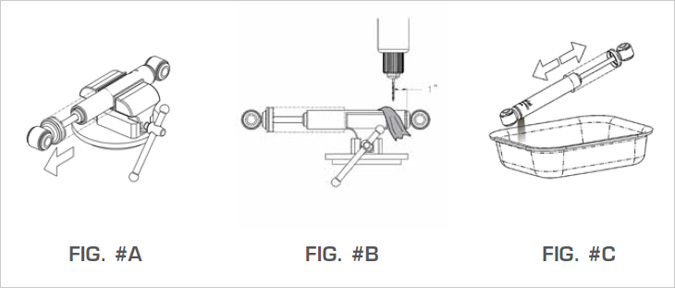Disposal Instructions
Appropriate protective measures, such as wearing safety glasses and protective gloves, should be taken when removing oil and gas from discarded and defective shock absorbers.
Procedure
| 1. | Secure the shock absorber in a horizontal position. Fully extend the piston rod prior to drilling the unit. (see FIG. #A). |
| 2. | Using a 1/8” (3mm) drill bit, drill a hole in a downward direction approximately 1.0” (25mm) from the bottom of the shock absorber to a depth of about 1.0” (25mm) (see FIG. #B). |
| 3. | Drill a second hole of about 1/8” (3mm) at 2.0” (50mm) from the top of the shock absorber to depth of about 1.0” (25mm), in order to allow all of the oil to flow out. |
| 4. | By moving the piston rod in and out, begin stroking the unit to completely purge the oil from the cylinder of the unit (See FIG. #C). |

Environmental Information
| 5. | Collect all used oil, being careful not to mix oil with any other waste or refuse. Store the used oil in an approved container clearly marked “Used Oil”. |
| 6. | Dispose of the remaining shock body and internal parts in accordance with your local, state, or provincial legislation concerning waste oil and other wastes. |
| 7. | Store, dispose, and/or transport used oil in accordance with environmental regulations and used oil program regulations in your state or province. |
Used shock oil may be disposed in the container used for recycling engine oils. Information on where to dispose of the oil and other parts can be obtained from environmental authorities or oil suppliers.
Gabriel cannot determine whether any particular customer is qualified to check or replace ride control, shocks or struts. Customers must make their own assessments of their experience, skills and knowledge and take responsibility for all results and if in doubt, seek the assistance of a qualified trained mechanic.
These videos are not intended to be step-by-step instructions, but are intended for general information purposes only.
Every vehicle is delivered with an OEM owner’s manual. If you cannot locate yours, several publications exist that will provide you with the specifications for the parts on the vehicle you are about to repair. Read the OEM manual specific to the make and model of your vehicle and the instructions that accompany your Gabriel product before undertaking any repair or replacement project. Always seek the advice or assistance of a qualified, trained professional when needed.
Before starting and vehicle repair or replacement project, you must have the proper training, tools, equipment and experience necessary to safely and correctly complete the project. This is especially important for anyone attempting to replace a worn strut or shock absorber, because failure to remove the worn part or install the replacement parts correctly on your vehicle may result in personal injury or damage to property.







